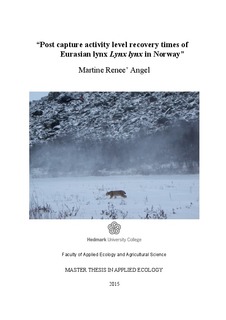| dc.description.abstract | Chemical immobilizations and handlings are commonly performed on numbers of
wild animals each year and are the main methods for radio collaring, collecting biological samples and measurements, and obtaining information on the health, reproduction, and age structure of a population. However, these procedures are associated with risks such as behavior changes, injury, or death to our study subjects, and research on capture effects is lacking. The Eurasian lynx Lynx lynx is a commonly captured species for research purposes in Norway, and there are few studies investigating capture effects on this species. Using activity data obtained from accelerometers mounted on GPS collars, I determined the recovery times of 33 Eurasian lynx in Norway from capture and recapture events (n=45) and
evaluated influences and differences on the recovery period in regards to capture methods, capture number, age, gender, pursuit time with helicopter captures, and whether or not surgery was performed. Overall, the current capture protocols and methods on Eurasian lynx do not have long lasting effects on the recoveries of the lynx from a capture event. Specifically, Eurasian lynx on average recover from a capture event within 2.0 days post capture. Age of the lynx was found to be the most influential factor on the recovery period. No statistical significance was found between capture methods, capture number, gender, age, or whether or not surgery was performed, although some differences in recovery times existed. Researchers should evaluate capture effects to not only ensure minimal human impact and continued existence of their study animals, but also to objectively refine capture methods as needed. | nb_NO |
